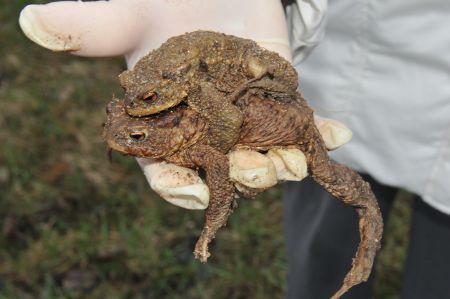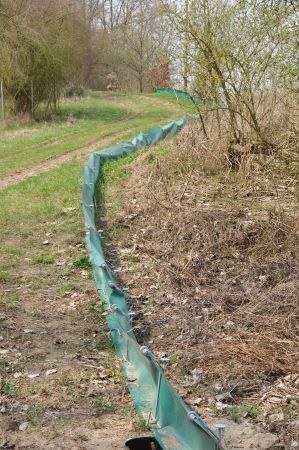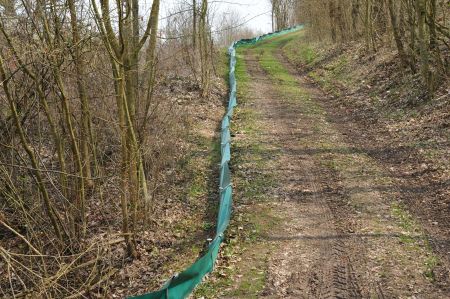On Thursday morning the time had come. We had arranged to meet the Przybylla couple on the country road between Marktbreit and Michelfeld for 8:00 a.m., right on the first section of the toad fence on the premises of the small animal breeding club.
After a short greeting and brief introduction of the people and the activities of the respective other, they immediately set off for the route, equipped with the collection bucket and sturdy shoes. While we were on our way with Ms. Przybylla, Mr. Przybylla drove his car to the second section of the toad fence in the forest area below, so that we could meet there after collecting the toads.
As part of a biology project for her daughter
 We quickly got into deep conversations and it became clear how Ms. Przybylla had gotten this job: as part of her daughter's biology project, she asked for help collecting the toads because her time schedule was different. Her daughter's project was completed about 15 years ago, but Mrs. Przybylla remained true to the toads. Today, the district office appreciates Ms. Przybylla's reliability and perseverance, and so, in addition to the inspection and morning collection at the toad fence from Marktbreit to Michelfeld, there is even a second section along the Main between Marktbreit and Ochsenfurt. Her husband, who has meanwhile retired, has also been part of the team of helpers for a number of years.
We quickly got into deep conversations and it became clear how Ms. Przybylla had gotten this job: as part of her daughter's biology project, she asked for help collecting the toads because her time schedule was different. Her daughter's project was completed about 15 years ago, but Mrs. Przybylla remained true to the toads. Today, the district office appreciates Ms. Przybylla's reliability and perseverance, and so, in addition to the inspection and morning collection at the toad fence from Marktbreit to Michelfeld, there is even a second section along the Main between Marktbreit and Ochsenfurt. Her husband, who has meanwhile retired, has also been part of the team of helpers for a number of years.
Mr. Przybylla discovers gray herons waiting for him
 It doesn't take long to walk the fence and check the collection buckets that are embedded in the ground every 20 meters or so. We find what we are looking for in the second bucket. A single common toad sits hidden under last year's foliage. It is carefully transferred to the collection bucket. At the next bucket there are four bucks and by the end of the first section, 47 bucks have been collected. In two places in this section, pipes have been laid under the road, which are also used by the toads due to their large diameter. Here the protective fence is broken. Mrs. Przybylla checked that this is actually the case by placing a container at the end of the pipe. Unfortunately, the toads cannot find these passages on their own, so protecting toads only makes sense by collecting them. At the meeting point between the two sections, Mr. Przybylla can also refer to a comparable number of toads.
It doesn't take long to walk the fence and check the collection buckets that are embedded in the ground every 20 meters or so. We find what we are looking for in the second bucket. A single common toad sits hidden under last year's foliage. It is carefully transferred to the collection bucket. At the next bucket there are four bucks and by the end of the first section, 47 bucks have been collected. In two places in this section, pipes have been laid under the road, which are also used by the toads due to their large diameter. Here the protective fence is broken. Mrs. Przybylla checked that this is actually the case by placing a container at the end of the pipe. Unfortunately, the toads cannot find these passages on their own, so protecting toads only makes sense by collecting them. At the meeting point between the two sections, Mr. Przybylla can also refer to a comparable number of toads.
Now it goes to the other side of the road, where there are some shallow pools behind a reed area. Here we carry the collection buckets with the croaking contents and release the toads into their spawning pools. Already on the way, Mr. Przybylla explains the problems that have already occurred at the ponds. It is generally known that herons and gray herons are very clever when it comes to their prey. Too often Mr. Przybylla has spotted gray herons waiting for him, looking forward to the "fresh delivery" of the toads. Crossing the road is not the only problem for the toads to survive, but also the reed field at the spawning pond itself. If it provides sufficient protection from the herons, the population can expand. On the other hand, the toad naturally belongs in the heron's prey scheme. As always and everywhere, maintaining the right balance is the most important criterion.
Thoughtlessness renders the toad fences useless
You drive along the Main to the next section of the toad fence. It was originally planned to place the fence directly along the road. Only after a few discussions was it then decided to equip the path along the forest or field path on the other side of the railway line, which was much safer for the supervisors. Here it was almost impossible for the toads to first cross the double-track railway line and then the busy country road to the wetlands on the Main. Of course, the question arose as to why the toad fences are only used at the beginning of spring, since the toad migration runs in the opposite direction in autumn. Here, too, the answers were immediately ready: in spring it is the spawning instinct that ensures that almost all toads make their way to the spawning grounds at the same time.
This hike is completed within a few days as soon as the temperatures have developed favourably. In autumn, on the other hand, the return migration takes place over months, so that there is no "mass die-off" of the toads on the roads. Mr. Przybylla tells of his experience on this section in particular, that it was dangerous even for drivers, because the road was downright slippery due to the toad carcasses. The erection of the toad fences is not only intended to protect the toads, the car and truck drivers also benefit directly from it. Too bad that their thoughtlessness often renders the toad fences inoperable, because the strong wind suction at high speed also lifts the safety fences. A slightly reduced speed in these sections hardly takes any time and helps to extend the maintenance intervals. All that is required is attentive drivers who drive particularly carefully during the short period in spring. If only in the interest of the safe activities of the toad caretakers.
Walking along a toad fence can also provide new approaches
This time we walk with Mr. Przybylla along the section along the forest, while his wife controls the meadow section. After just a few meters, more than 50 toads have been collected, at the end of the section there are 147 croaking frogs. Here again the prudence of the Przybylla couple is shown, because they start collecting at the end of the route. One should not underestimate the weight of 147 bucks. On the way, we are also told of accidents involving wildlife along the railway line. Again and again Mr. Przybylla has to inform the forestry office because deer are dead along the route. Our high-tech, fast-moving times often mean death for the animal world. Quite apart from the fact that many species “simply” die out due to environmental conditions. And it is precisely this diversity of species that is being tried to be preserved, in which frogs also play an important role.
Sometimes we treat nature too carelessly. A walk along a toad fence can also provide new approaches and stimulate your own reflection. If you, dear reader, have any further questions or suggestions, please send us an email. As always, this will be forwarded to the people involved.
Please read as well:
Berat – Stadt der tausend Fenster - Osmanisch geprägt
Zegrze-Stausee, Narew und Bug – Wetter im November
